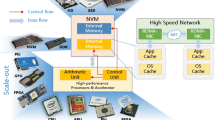Abstract
The general specifications and design for a High-Speed General Information Management System, HSGIMS, to serve as the basis for a Global Information Network are given. Some of the key specifications that have been confirmed in experiments with a prototype of the HSGIMS are:
-
(1)
Information (or data) and Question-type (or logical data) independence.
-
(2)
Very small bounded search times that are independent of the amount of information that is managed and can be computed exactly.
-
(3)
A fool-proof security system that can be used to protect databases against viruses and can also be easily invoked to deny unauthorized access by users.
-
(4)
Efficient use of all storage and communications resources.
Similar content being viewed by others
References
P. A. D. de Maine, K. D. Bradley and S. M. Jodis, “SOLID: A general high-speed logical data management system with bounded search times.”Online & CD_ROM Review 17, pp. 1–8, 1993.
P. A. D. de Maine, “HSGIMS—A high-speed tool with bound search times for transparently managing and manipulating information,”Proceedings of CIKM-93, 1993, pp. 216–222.
P. A. D. de Maine, K. D. Bradley, W. H. Carlisle, and W. B. Dress, “Integrated systems I. Design principles.”J. of Systems Integration 5, pp. 187–200, 1995.
P. A. D. de Maine, “Design principles for discipline independent rule based systems.”Foundations of Computing and Decision Sciences 19, pp. 115–125, 1994.
P. A. D. de Maine, and M. M. de Maine, “Computer aids for chemists.”Anal. Chim. Acta 235, pp. 7–26, 1990.
K. D. Bradley, and P. A. D. de Maine, “Integrating rule based systems to perform command and control function.”Second International Symposium on Knowledge Acquisition, Representation and Processing (KARP-95) ABSTRACTS, 1995, pp. 12–15.
K. D. Bradley, and P. A. D. de Maine, “High-speed tools for global information management II. Integrating rule based systems to perform command and control functions.”J. of Systems Integration-(submitted).
K. D. Bradley, and P. A. D. de Maine, “Design and applications of discipline independent rule based systems.”Proc. of Second Expert Systems World Congress Vol. 1, Lisbon, Portugal, 1994, pp. 1023–1031. (Published on CD-ROM)
K. D. Bradley, “AUTOMATIC CLASSIFICATION, IDENTIFICATION, AND INFORMATION SYSTEM: An integrated systems approach to automated target recognition in a multiple sensor multiple platform environment.” Series: Automatic Systems for the Physical Sciences, CSE-91-08, Computer Science and Engineering Department, Auburn University, Auburn, AL 36849, Report No. 22, 104 pages (May/1991).
J. van den Burg, “Telecommunications-related information services.”Proceedings of the NATO Advanced Study Institute on Information Technology and the Computer Network, Bonas, France, August 21–September 2, 1983.
O'Reilly and Associates,The X Window System Manuals. Volumes 0–8, 1990.
F. Anklesaria, et. al., “F.Y.I. on the internet gopher protocol (A distrihuted document search and retrieval protocol).”Network Working Group, University of Minnesota, MN, Internet RFC14346 March 1993.
T. J. Berners-Lee, et al., “World-wide web: The information universe.”Electric Networking: Research, Application and Policy 2, pp. 52–58, 1992.
B. Kahle, “An information system for corporate users: Wide area information servers.”Technical Report from Thinking Machines Co., April 1991.
G. C. Kessler,ISDN, McGraw-Hill Inc.: New York, NY, 1990.
C. J. Date,An Introduction to Database Systems. VolumeI Fourth Edition, Addison Wesley Publishing Company, Inc.: New York, NY, 1986.
Y. Gong, and P. A. D. de Maine, “An infrastructure for global information retrieval.”Second International Symposium on Knowledge Acquisition, Representation and Processing (KARP-95) ABSTRACTS, 1995, pp. 38–41.
Y. Gong, “High-speed tools for global information management IV. An infrastructure for global information retrieval.” (In preparation).
A Mathematically Complete orPhilosophically Closed system or language is defined as one that can be used to describe any problem in its domain. Neither the efficiency of a particular formulation or a unique way of describing a problem is implied. Examples of such systems are natural languages and matrix algebra. The efficiency of a particular formulation is determined by economic factors like the amount of computer time. While matrix algebra can be used to solve a particular problem in a great many different ways, the most efficient solutions are those which require the minimum number of applications of the rules of matrix algebra and take the least amount of computer time. TQL is mathematically complete because: (i)any information canalways be described in graphical (or abstract network) form, (ii) the meaning of a graphical formulation is a matter of interpretation, and (iii) TQL can be used to describe visits to any number of nodes in any order. TQL is a query language because it can be used to formulate queries for retrieval purposes and a manipulative (or data description) language because it can be used to describe the characteristics of information that may or may not be retrieved. A variant of this concept-mathematical equations are not merely empirical descriptions of the physical sciences-has resulted in the discovery of the Special Theory of Relativity, by Albert Einstein, and both Positrons and Antimatter, by P. A. M. Dirac.
P. A. D. de Maine, and D. E. Whitten, “Design for a distributed information network.”Advances in Information Systems Science 7, pp. 89–155, 1978.
P. A. D. de Maine, and D. E. Whitten, “Automatic organization of files III. JOBLIST language.”Management Datamatics 4, pp. 31–47, 1975.
P. Xia, “Normalization in the solid system.”Automatic Systems for the Physical Sciences, CSE-92-01, Computer Science and Engineering Department, Auburn University, Auburn, AL 36849, Report No. 23, 128 pages April 1992.
P. A. D. de Maine, and N. F. Chaffee, “File security in an information independent data management system.” inManagement Information Systems: Selected Papers from MIS Copenhagen 70 IAG Conference, W. Goldberg et al. Editors, Auerbach Publishers Inc., Princeton, New Jersey, 1971, pp. 487–519.
T. Rotwitt, and P. A. D. de Maine, “Storage optimization of tree structured files representing descriptor sets.”Proceedings of the ACM SIGFIDET Workshop on Data Description, Access and Control, pp. 207–217, 1971.
P. A. D. de Maine, “Automatic curve-fitting I. Test methods.”Computers and Chemistry 2, pp. 1–6, 1978.
P. A. D. de Maine, and K. G. Price, “Integrated systems II. Multi-tier interfaces for integrating heterogenous families of systems.”J. of System Integration 5, pp. 201–217, 1995.
P. A. D. de Maine, and K. D. Bradley, “High-speed tools for global information management III”Applications of the Transparent Query Language (TQL), (In preparation)
G. K. Springer,AGISAR: A System for Automatically Classifying Digitized Pictorial Data, PhD Dissertation. The Pennsylvania State University, Computer Science Department, August 1970.
G. K. Springer, “Automatic classification of digitized pictorial data for storage and retrieval.”Management Informatics 1(3/4) June/August, 1972.
G. K. Springer, “Pattern recognition meets information retrieval.”Proceedings Second Texas Conference on Computing Systems, Austin, Texas, November 1973.
P. A. D. de Maine and B. A. Marron, “The SOLID system I. A method for organizing and searching files.” P. A. D. de Maine and B. A. Marron, inInformation Retrieval: A Critical View, G. Schecter ed., Thompson Book Co.: Washington, D. C., 1967, pp. 243–282.
P. A. D. de Maine, P. A-B. Ng and M. M. de Maine, “Perception and identification of entities in different environments.”Automatic Systems for the Physical Sciences, Computer Science and Engineering Department, Auburn University, Auburn, AL 36849, Report No. 11, 35 pages, March, 1987.
J. A. Craig, S. C. Berezner, H. C. Carney, and C. T. Longyear, “Deacon: Direct English access and control.”Proc. Fall Joint Computer Conference, 1966, pp. 365–380.
P. A. D. de Maine, and K. D. Bradley, “Research notes for the JOBLIST/SOLID system.”Automatic Systems for the Physical Sciences, CSE-90-05, Computer Science an Engineering Department, Auburn University, Auburn, AL 36849, Report No. 19, 23 pages, September/1990.
J. M. Bray, V. P. Nelson, P. A. D. de Maine and J. D. Irwin, “Data-compression techniques+Ease storage problems,”Computer Design 24, pp. 102–106, 1985.
P. A. D. de Maine, and G. K. Springer, “Data compression and decompression system.”United States Patent 3,656,178, April 11, 1972.
P. Szekely, “Separating the user interface from the functionality of application programs.” Computer Science Department, Carnegie Mellon University, Pittsburgh, PA, Report CMU-CS-88-101, 208 pages, 1988.
R. E. Savage, and J. K. Habinek, “A multilevel menu-driven user interface: Design and evaluation through simulation.” in HumanFactors in Computer Systems, J. C. Thomas and M. L. Schneider, Eds., ABLEX: Norwood, N.J., 1984, pp. 165–186.
P. A. D. de Maine, B. C. Cartee, M. S. Wojtyna and M. M. de Maine, “A computer tool kit for chemists I. Design considerations for interfaces.”J. Chem. Inf. & Comp. Sc. 30, pp. 155–159, 1990.
B. Shneiderman, “Response time and display rates in human performance with computers.”Computing Surveys 16, pp. 265–285, 1984.
M. Edhala, and P. A. D. de Maine, “The QBE/SOLID interface.”Automatic Systems for the Physical Sciences, CSE-89-08, Computer Science and Engineering Department, Auburn University, Auburn, AL 36849, Report No. 14, 8 pages, January 1988.
D. M. Head, and P. A. D. de Maine, “The SOLID interface manual”Automatic Systems for the Physical Sciences, CSE-89-07, Computer Science and Engineering Department, Auburn University, Auburn, AL 36849, Report No. 13, 38 pages, January, 1989.
D. M. Head, and P. A. D. de Maine, “A high-speed management system for checking and retrieving designs of computer components.”Automatic Systems for the Physical Sciences, CSE-89-06, Computer Science and Engineering Department, Auburn University, Auburn, AL 36849, Report No. 12, 5 pages, January, 1987.
D. M. Head, “The SOLID-user interface,” M.S. Thesis, Auburn University, 1987.
P. A. D. deMaine, and K. C. O'Kane, “A national retrieval system for the physical and biomedical sciences.”Proc. First Texas Symposium on Computer Systems, 1972, pp. IV.1.1–IV.1.13. (IEEE Computer Society, 5855 Naples Plaza, Long Beach, California 90803).
P. A. D. deMaine, K. C. O'Kane, and T. Rotwitt, “An automatic information processing and retrieval system for factories, corporations and regions.” presented at theInternational Symposium in the Use of Electronic Computers in Chemical Engineering, (Paris, 1973); also in:Management Informatics 2, pp. 251–264, 1973.
K. C. O'Kane, and R. J. Hildebrandt, “An integrated health information processing and retrieval system.”Proceedings 1974 AFIPS NCC&E 43, p. 93–105, 1974.
K. C. O'Kane, P. A. D. deMaine, and R. J. Hildebrandt, “A proposed integrated regional health information system.”Management Datamatics 4, p. 139–147, 1975.
P. A. D. de Maine, S. Leong and C. G. Davis, “A transportable programming language (TPL) system I. Overview.”Int. J. Comp. and Information Sciences 14, pp. 161–182, 1985.
S. Leong, S. Jodis, K. Sullivan, O. Jiang and P. A. D. de Maine, “A transportable programming language (TPL) system II. The bifunctional compiler system.”I.E.E.E. Trans. on Software Engineering 16, pp. 639–646, 1990.
R. Ramakrishnan, “Design and implementation for a high speed retrieval system with bounded search times.” M.S. Thesis, Auburn University, 1986.
Author information
Authors and Affiliations
Rights and permissions
About this article
Cite this article
De Maine, P.A.D., Bradley, K.D. High-speed tools for Global Information Management I. Information processing and retrieval. Journal of Systems Integration 6, 217–240 (1996). https://doi.org/10.1007/BF02265087
Received:
Revised:
Issue Date:
DOI: https://doi.org/10.1007/BF02265087




